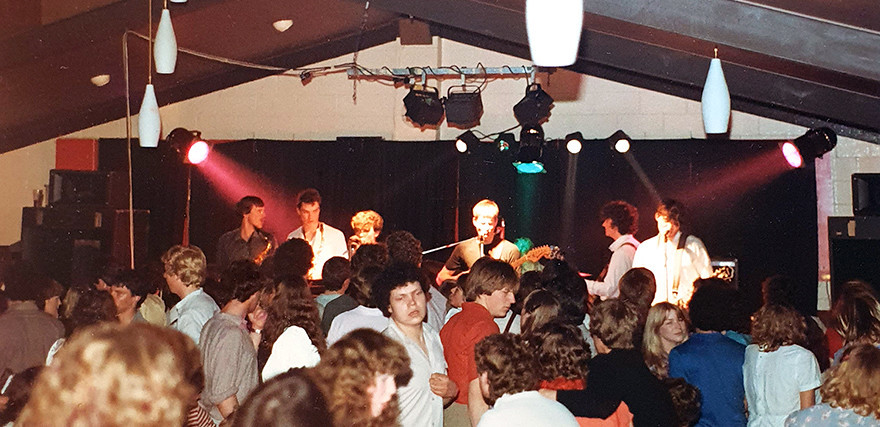
Netherworld Dancing Toys onstage at the Oriental Tavern, Dunedin, 1982. Photo by Ged Taylor
The debut party no one remembered...
On June the 11th 1982, Netherworld Dancing Toys held what was billed as our “Consummation Party” at the Orphans Hall in Clyde Street, Dunedin, 100 metres from the Oriental Tavern. Why it was called the Orphans Hall, no one knew.

Netherworld Dancing Toys onstage at the Orphans Hall, Dunedin, 11 June 1982. - Nick Sampson Collection
We’d never played a show but our bass player Graham Cockroft had booked Andrew Brough’s Blue Meanies as support act anyway. Five-hundred tickets had been sold to university friends (there were a lot of us in the band) with the promise of an open bar, for a gig in a room with a 300 capacity.
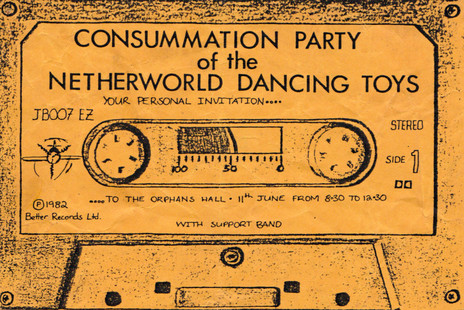
Invitation to the Netherworld Dancing Toys' "Consummation Party" – Orphans Hall, Dunedin, 11 June 1982. - Nick Sampson Collection
Two mini tankers of Speights and an ill-judged assortment of spirits were brought in. Several over-enthusiastic student barmen found temptation too much and were legless by the time the doors opened. Unsurprisingly things became a free for all. Then the PA broke down as the Blue Meanies finished. Soundman Tex Houston managed to fix this after a prolonged break. By then it was 10pm and 500 sweaty friends and the odd lecturer were very well lubricated. As we walked on stage the hall erupted. In fact, it went mental. Bottomless booze and the technical delay had combined to create the most overexcited debut audience possible.
The next day no one could really remember our set, my flatmates included. Over hungover morning cuppas stories of various escapades were recounted. But the main topic seemed to be that while they thought the band must have been good, they’d have to see us again to make sure.
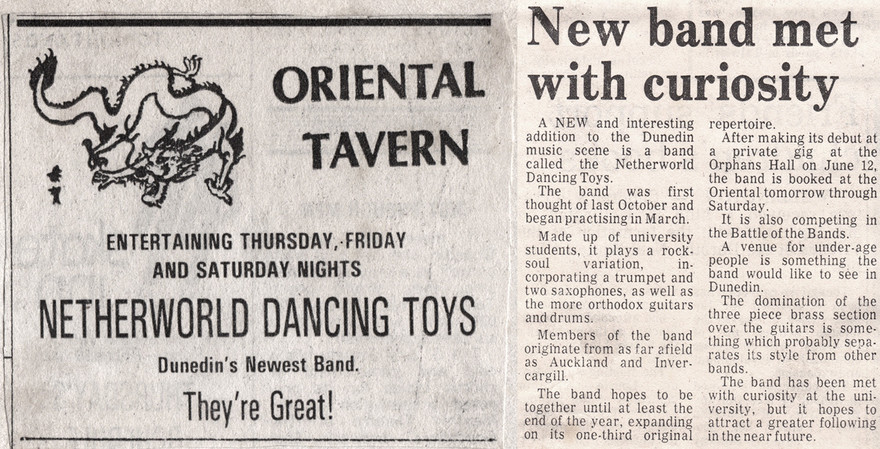
"Dunedin's newest band, they're great!" / "New band met with curiosity" – Otago Daily Times advertisement and early press clipping for Netherworld Dancing Toys, June 1982. - Nick Sampson Collection
That next time happened at the Oriental the following weekend, a venue for which I would end up managing bookings, less than a year later.
Welcome to The Oriental
In what seemed a pretty optimistic move prior to the launch party, Graham had organised us to play there the following Thursday, Friday and Saturday nights. How he did this for an unknown band I don’t remember. I do remember walking through the campus with my guitar to the first gig and being astounded to see a queue outside waiting for the doors to open.
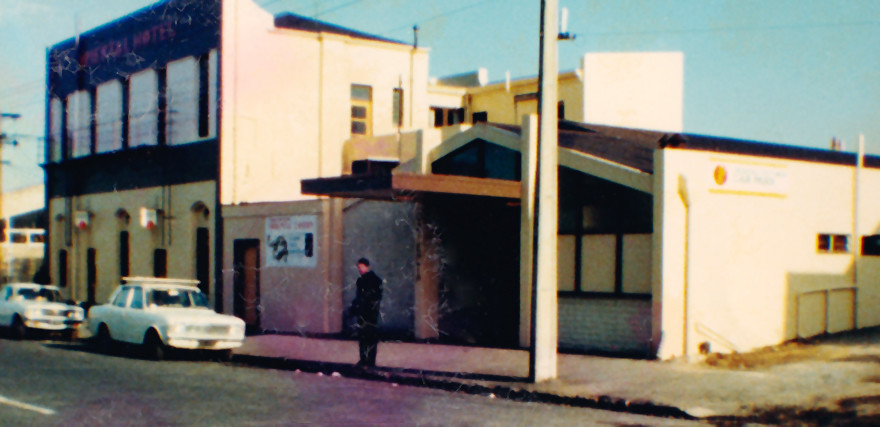
Oriental Tavern exterior - Nick Sampson Collection
Many were back to see if we were any good after all. This word of mouth and the pre-internet power of a photo and story in the local paper, along with the first of many NDT poster blitzes, meant these first Oriental shows were packed.
Making the front page of the ODT
That first weekend wasn’t without incident. Scarfie-bashing was prevalent at the time, with carloads of South Dunedin bogans cruising the Northeast Valley looking for students to give a good kicking. It was a local news story.
The first weekend wasn’t without incident: Scarfie-bashing was prevalent at the time.
After our gig on the Saturday, we grabbed a crate and headed to the nearby flat of our new lighting tech, Gerard (Ged) Tully, who had joined us with some experience doing theatre work. We’d only just arrived when there was a commotion, and several strangers came barging in. They’d been at the gig and followed us. Sitting on a couch several of us ducked as a coffee table was hurled at the wall behind. Bottles were broken. Graham tried to reason with the ringleader for a few seconds before being clocked on the nose, resulting in a spectacular volume of blood. Ged was in the kitchen dialling 111.
South Dunedin’s finest soon legged it, roaring off in an old banger. The place was seriously smashed up, as were some of us, and there was no sign of the cops. Forty-five minutes later a patrol car pulled up slowly with two uninterested boys in blue. We made statements. One of the culprits had been in our drummer Brent’s class at Otago Boys. They didn’t seem to care. It was ironic given the plod’s enthusiasm for sending squads into student pubs to nab underage drinkers. All but two of us had been booked recently at a post-practice band meeting over a quiet jug in the Robbie Burns.
After they left Ged announced it had been nice meeting us, but this rock’n’roll carry on was a bit lively for him and he’d stick to theatre lighting. He later became rector [headmaster] at St Patrick’s College in Wellington.
His long-term replacement was another Ged, Ged Taylor, who became a key part of the NDT team. He only endured one post-gig attack from memory, in Invercargill the following year. But that’s another story.
A week passed and there was no contact from the constabulary. I tried calling a couple of times. No one rang back. In the end, full of youthful umbrage, Matthew our alto sax player and I penned a letter to the editor of the Otago Daily Times (ODT), calling out the underage raids in comparison to our experience with the police. With no forewarning the letter was featured in the lead article on the paper’s Saturday morning front page, quoting “Messrs Sampson and Trbuhovic”, along with the Police Commissioner, who claimed we’d been contacted and informed about enquiries. Fascinating. Still, it was good publicity.
Several months later, again unbeknown to us, two of the bogans were jailed. Brent’s ex-classmate got 18 months.
A time of multiple venues
We went on to play the Oriental and its nearby counterpart the Captain Cook dozens of times. Both were medium-sized rooms that featured all the Dunedin bands plus occasional visits from groups north of Mt Cargill.
These shabby but much-loved venues were where local music lived and flourished.
These shabby but much-loved venues, all within a stone’s throw of each other – the lounge-room sized Empire Tavern, the University (with its big Union Hall, common room, and Terrace Lounge where I saw era-defining shows by The Chills and Sneaky Feelings) and Sammy’s – were where local music lived and flourished.
Other than the university they’re all closed today. During the 80s and for years after each was great for bands and audiences alike.
But for me the Ori (or the Bori Ori as some called it) had something special and unique, even if it was really just an ugly, rectangular concrete-block box. And for the first couple of years, it really did seem like our “home gig”.
What made it work?
A 1970s, single-floor addition to the older two-story pub, The Ori’s lounge bar hadn’t troubled any of the city’s architects. As with other venues, when it was humming the air was thick with cigarette smoke, your shoes would stick to the carpet, and on particularly busy nights the walls would run with sweat and condensation.
We had a lot of busy nights. The capacity was 220, but often 300-400 people packed into the room. Loud. Beer soaked. Fun. It was always a celebration. The crowd (we knew most of them) and the band were part of something exciting and uniquely ours.
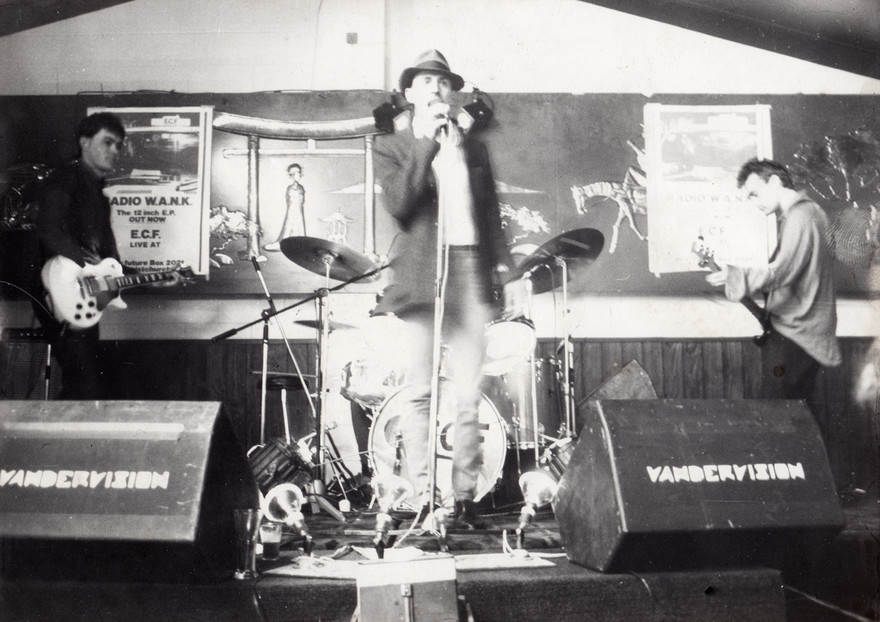
Eddie's Hot 4 onstage at the Oriental, Dunedin. From left: Nick Sampson, Marco Devcich, Robbie Yeats (drums, obscured), Shane Tibby. - Nick Sampson Collection
On paper it was a basic, functional space. There was no real ambience. A long bar ran down the left-hand side and there was a small dancefloor up front. The right half was taken up with leaners and Formica tables, each with a screw-top, water-filled jar ashtray fitted into a hole cut into the top.
Lighting from the old 1000W par cans raised the onstage temperature to furnace levels.
The stage at the far end faced back towards the double doors onto Clyde Street. About half-a-metre high, it was a decent size with a flat wall behind, good for flying backdrops that would cover the oddly incongruous red and gold Chinese mural – a nod to the bar’s name.
Like the Cook, the ceiling was low, creating an intense connection between the sardine-packed crowds and the bands up front. It was pitched in the middle and dropped at the sides, meaning lighting from the old 1000W par cans was rigged just above head height, raising the onstage temperature to furnace levels. A couple of these aimed at you felt like they were burning in a Dunedin suntan. Lighting techs enjoyed targeting hapless band members and sodden, sweat drenched clothes became the norm.
It certainly wasn’t pretty or fragrant in the daylight. No venues are, but like flatmates who suddenly look glamorous all dressed up for the med ball (before it goes wrong a hundred wines later), the room sparkled into life when it became what it was there for. A hot, even cosy oasis to escape into during the depths of a Dunedin winter.
The difference between the cold, empty street outside was vivid as you crossed the threshold directly off the footpath into a mass of humanity, noise, dim lighting, and rock’n’roll bar smell. An inviting space flowing with three-star gold medallion Speights ale, hosting the most exciting music in the country as far as we were concerned.

Mark (Marco) Devcich from Eddie's Hot 4 with Seamus McNulty and friend at the Orphans Hall, 1982. Netherworld Dancing Toys bassist Graham Cockroft is at right. - Nick Sampson Collection
Tucked in beside a row of two-storied Coronation Street-style student flats, I was always felt it was more of a spiritual home for the varied Dunedin scene than the other venues. From the more mainstream audiences whooping it up at the crammed NDT shows, to the mass of black jerseys and jackets (my uniform too) earnestly standing shoulder-to-shoulder for the more obviously Flying Nun bands. Yet perhaps because it was in such a quirky old building and lasted longer, it’s the Empire that has gained that mantle down the years. Even though it was some distance away on the other side of the CBD from Scarfieville.
Tiger Taylor – the Bouncer
Immediately inside punters would receive a stern welcome from Tiger Taylor and a small cover charge had to be paid. In our case usually to my cousin Seamus McNulty sitting at a rickety table with a cashbox and stamp in his ever-present purple jersey and Doc boots. Possibly the rudest door person in town. That was his schtick.
He was a fixture on the local scene, keeping his beady eye on things at various pubs.
Tiger wasn’t to be messed with. A burly, older, Brylcreamed Brit who looked and sounded a lot like Windsor Davies of It Ain’t Half Hot Mum fame, he was a fixture on the local scene, keeping his beady eye on things at various pubs.
Local legend had it he’d been a professional wrestler in the UK and had “disappeared” to Dunedin after killing a man in the ring. I never asked him. Others in the band remembered Tiger refereeing wrestling matches at the town hall in the late 70s. Bulging in his white T-shirt with tattooed Popeye forearms, adjudicating household names such as King Curtis, Rick Martell and Mark Lewin, all stars of TV’s On the Mat.
Tiger was always immaculately turned out and had a propensity to suggest troublemakers might have their heads put up their backsides very quickly. He loved the NDTs. I think he enjoyed being part of something that was successful and pulling the crowds, and never suggested our heads needed to be anywhere but on stage. A colourful character and a nice bloke, he would wind up every evening at closing time shouting “come on now me lovelies, you must have homes to go to” in his singsong voice.
Warren Cates – the Manager
Warren was a nice bloke too, father of Gus, one our music-loving friends. Like most pub managers he knew as much about modern music as I knew about running a boozer. But he could smell money in them there bands, and gigs were becoming more frequent. One day in early 1983 he asked Graham and I if we might be interested in helping run that side of things. At a time when most local bands frowned on organisation as uncool, we were self-managed, seemed to know what we were doing and were his biggest drawcard. So, I suppose it made sense.
The job I wasn’t looking for
I wasn’t sure but Graham immediately suggested I do it. Perhaps a sign of the delegation skills that would play a role in his future corporate success. Years later, after we’d arrived in London together and found typical temp jobs, he went on to manage British Gas in South America, as you do. He also set up Radio One, Otago’s student radio station (yours truly was an early DJ), and the nationwide Student Radio Network, to facilitate volume ad-buying discounts for all the stations by providing advertisers easy access to national campaign placement.
Looking back, I wonder if he me saw running The Ori as a way of focusing my tardy life skills. Just turned 20, tying my boot laces and balancing my cheque book were still a challenge – and probably remain so figuratively. It must be said, my year or so promoting shows did catapult me forward – along with taking on marketing and media liaison responsibilities for the NDTs. This ultimately led to work in arts marketing and management, and later a career in brand strategy.
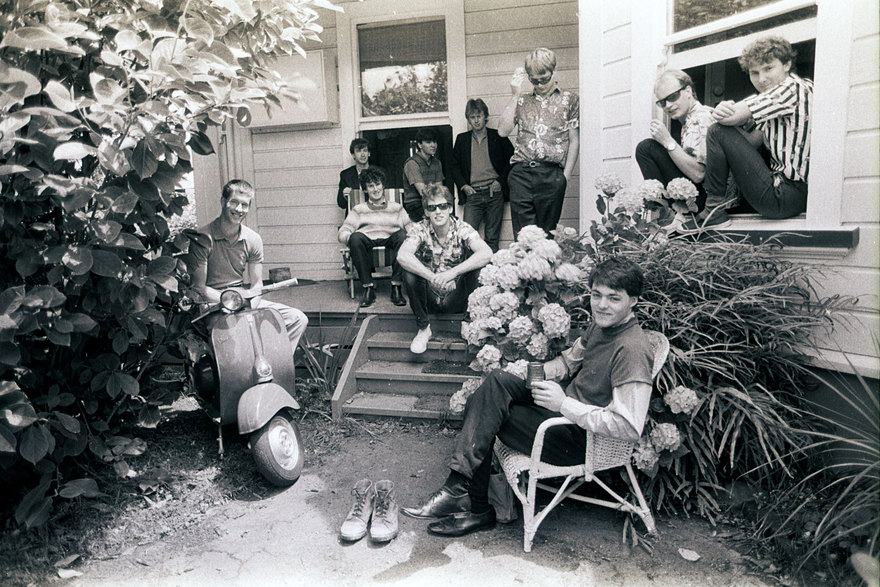
Netherworld Dancing Toys in 1984. Left to right – Malcolm Black, Neville Schwabe, Graham Cockroft, Steve Renwick, Paul Docherty (roadie/entertainment officer), Gary Valentine, Tex Houston (sound), Nick Sampson, Ged Taylor (lights), Brent Alexander - Photo by Bruce Maunsell. Nick Sampson Collection
Others in the NDTs also ended up with careers that started with those early Dunedin gigs. Malcolm Black as a well-known music lawyer and industry figure. Tex Houston, who became Flying Nun’s go-to live sound and recording engineer, and producer, and latterly creator of Tex Tones – top-end home audio speakers. And lighting man Ged Taylor, who built corporate-event production company Kiio. That smoky little bar played an important starting point for all of us.
In at the deep end
So I had a job. Yikes. I remember being somewhat daunted. I started putting together a contact list, making calls on the flat’s Bakelite phone and talking to other musicians around town. I remember a book with lots of dates and phone numbers, along with a few times early on when it all seemed a bit stressful. But gradually I learned the ropes.
I soon learned that organising and coordinating some bands was like shovelling smoke.
The ODT and Critic (the student paper) proved supportive. Articles were published and ads placed. Buckets of glue were lugged around the CBD and varsity on poster runs. PAs and lights were booked. Sound and lighting techs were organised for groups who didn’t have their own. Sometimes I manned the cashbox when a band’s door person didn’t show. Progress meetings were held with Warren and Eileen – his trusty bar manager, ashtray emptier and all-round good sort. And Tiger Taylor kept ironing his immaculate shirts.
I soon learned that organising and coordinating some bands was like shovelling smoke, wondering at this “could care less” approach. But not everyone was useless. Some like Sneaky Feelings and The Verlaines were super organised and easy to work with.
Up and running ...
Gradually shows were lined up well in advance and the routine of organising, coordinating, and promotion fell into place. Things ran reasonably smoothly, and it was fun, providing some much-needed beer money. I also got to see plenty of great shows. The Sneakys, The Verlaines, The Chills, The Blue Meanies, The Orange (another Andrew Brough band), Look Blue Go Purple, The Rip (or sometimes Alastair Galbraith solo) and The Alpaca Brothers. Also Working with Walt, fronted by Rob Hellriegel (his sister Jan Hellriegel later joined) with a pre-Straitjacket Fits Dave Wood on bass, The Backdoor Blues Band and the Doublehappys. The NDTs also played on a regular basis.
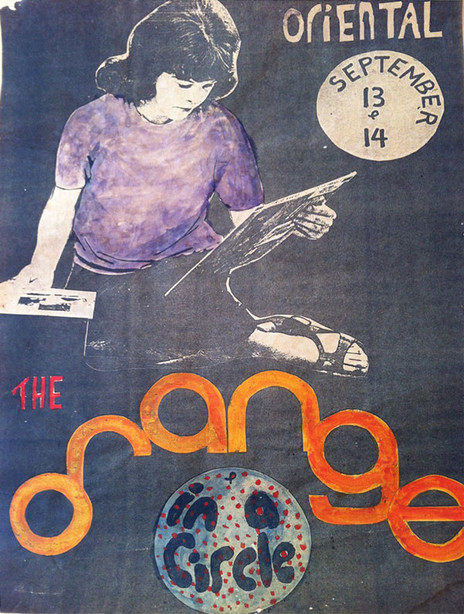
Inspired by the Dollar Day Afternoons at Auckland’s Windsor Castle we started running $1 shows once a month at 2pm on Saturdays. The well-known bands were happy to be involved for a share of the small take. Local busker Luke Hurley played a few and long-forgotten names such as Nick Sceats (Mr Jones & the Comic Strip Kids), Parson’s Nose, Eddie’s Hot 4 and PD Boiz had the chance to hit the boards.
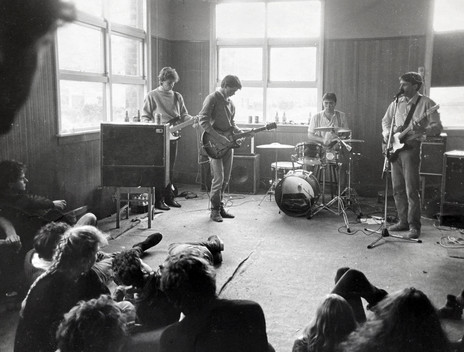
Parson's Nose at the Netherworld Dancing Toys' rehearsal space, Roslyn Mills, Dunedin. - Nick Sampson Collection
PD Boiz were Dunedin’s only oi-style boot band, with skinheads, overcoats, 10-hole Doc Martens lace-ups and the obligatory dog on a rope. They made a righteous racket and looked suitably fearsome. It wasn’t easy for them to get gigs, given the nature off the local scene and their lack of appeal to publicans. Of course, they were absolute teddy bears. Friendly, helpful and keen. Warren wasn’t so sure, but they did a few shows and pulled a different crowd.
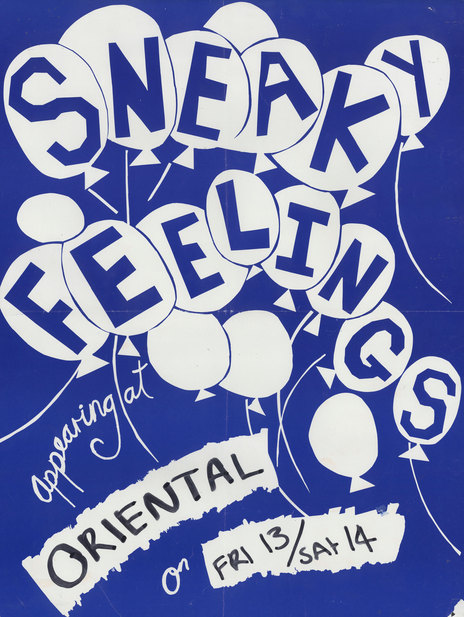
Sneaky Feelings at Dunedin's Oriental Hotel, month and year unknown; design by Jeremy Freeman
I was also part of a noisy, very un-NDT side project called Eddies Hot 4 which provided the chance to turn my guitar up to 11 and stretch things out a bit. Initially with drummer Robbie Yeats, a fresh-faced kid from Gore who went on to join The Verlaines and later The Dead C, as well as bass player Shane Tibby and frontman Marco Devcich. Brent from the NDTs replaced Robbie and we rehearsed in the Sneakys’ George Street practice room above his father’s grocery store. Dollar Day Afternoon shows were the enjoyable peak of our short career.

Look Blue Go Purple and W.S.S.O.E.S gig poster, Oriental Tavern, Dunedin, mid-1980s. - Posters collection, Hocken Collections, Uare Taoka o Hākena,University of Otago. S15-548a
While there were some rivalries and cliques it all felt like “part of the times”, a scene where anyone could get up and play to their friends on a Saturday afternoon. What else was there to do on a drizzly, winter weekend in Dunedin? We drew good crowds with people tending to sit on the dance floor chewing on jugs of beer and rolling ciggies.
Bands from the North
As The Ori’s reputation spread, touring bands started approaching us. Auckland’s Miltown Stowaways played a successful weekend on what was supposed to be their final tour before heading to the UK. I also helped them book a show at the university on the Sunday night.

‘Broken Limbs, Fond Goodbyes’. Rip It Up writer Mark Everton followed the Miltown Stowaways when they played and recorded demos in Dunedin’s Oriental Tavern. Read the story at Papers Past - Rip It Up / Papers Past
At a party after the Saturday show they challenged the NDTs to a soccer game the next afternoon at Otago Boys. The Aucklanders turned up full of bravado and spliffs, tumbling out of their van sporting DM boots to a man. The score was 2-0 to the visitors (very handy on the field as it turned out) when their bass player Mark Dansey went down in a sliding tackle from Mal, breaking his leg in three places. The loud crack was nauseating. Mark was delivered to A&E, but the university show went on with the remarkable John Dodd (older brother of Tim and Jane) roped in to learn their entire set at sound check.

Excerpt from Mark Everton’s ‘Broken Limbs, Fond Goodbyes’ story on the Miltown Stowaways’ visit to Dunedin’s Oriental Tavern in Rip It Up #81, 1 April 1984. Read more at Papers Past.
Christchurch bands like The Wastrels and top 10 punksters ECF also played. The Wastrels became friends. I don’t think Dance Exponents played, although I could be wrong. The Cook was their main Dunedin venue. But their friends The Punch did: another Timaru band who’d moved to Christchurch to give things a crack.
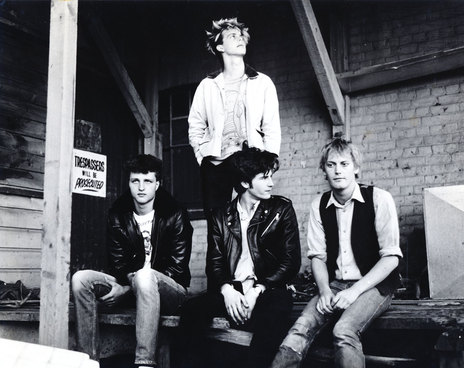
The Wastrels - Murray Cammick Collection
The irrepressible Rodney Hewson played keyboards in The Punch on an old ironing board and had booked pub venue The Creek in Timaru for early NDT shows. Later he was foreman for a gardening company in London where most of the Exponents earned a living while he enjoyed gins with Peter O’Toole on his deck overlooking the Thames. On returning home “Rodders” became A&R manager at Sony alongside Mal. Well-known photographer Kieran Scott was also in the band. The Punch were fun even if success eluded them. There was always a party when they came to town, where the guitars (and on one occasion an antique harmonium) came out.
These out-of-town bands highlighted the difference between the local scene and the rest of the country, both musically and sometimes in terms of smaller pulling power.
Moving on up ...
Like all things my time at The Ori ran its course. It had been great. Initially challenging, then rewarding, and definitely a steep learning curve mixed in with a bit of growing up. By 1984 the bands that brought the venue to life had made it an established and successful part of the Dunedin scene. But I’d never had serious promoter ambitions and eventually got bored with the ongoing cycle of organising other people’s gigs. More importantly, I had my sights set on my own musical future, and the NDTs were stepping up as a national touring and recording band.
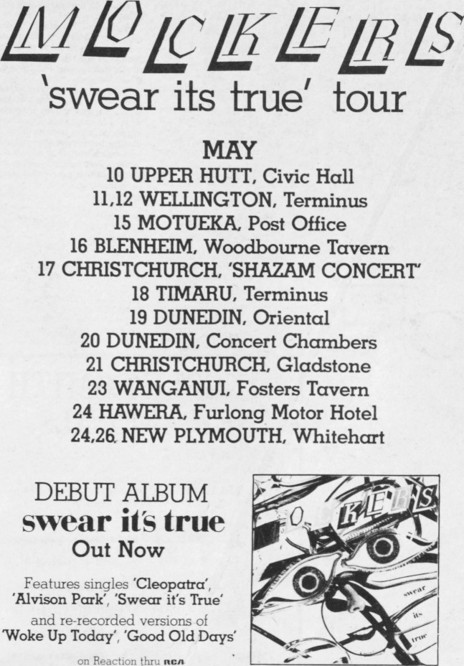
The Mockers 1984 'Swear it's True' tour takes in Dunedin's Oriental Tavern. - Rip It Up / Papers Past
I don’t remember exactly when or how it came to an end, or the last show I organised. But I do remember a kaleidoscope of snippets. Images of hot, sweaty, often raucous performances. The rewarding feeling of seeing the venue in full flight, packed with people in from the cold having a great time. Watching so many wonderful bands at their peak during a unique period in the country’s musical history – one particularly intense Saturday afternoon performance by The Verlaines is etched in my memory.
I also remember Warren Cates and his glee, pouring us a post-closing time jug after counting the bar take on a good night.
And I’ll never forget Tiger Taylor. Bless him. “Come on now me lovelies ...”